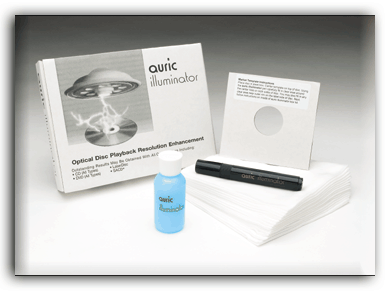Treat the Reflection; Trick the Refraction!
| Treat the Reflection; Trick the Refraction! |
| The Auric Illuminator CD Treatment |
|
Jim Dowd |
|
2 January 2000 |
Auric Illuminator
$39.95 per box
Manufactured by Audience
1525 Brian Place
Escondido, CA 92025-5551
(800) 565-4390
www.audience-av.com
“The Auric Illuminator did the same thing to Frank Del Vol’s string arrangements accompanying Ella’s vocals, bringing them revived bloom and focus. Some of Ella’s statements were followed by a pause and punctuated by neatly placed bass lines.”
It’s a beautiful thing when an unexpected surprise turns the corner and gets my audiophile juices flowing once again. So it has been with my review sample of the Auric Illuminator. This is an optical CD resolution enhancement product supplied by the company Audience, LLC located in Escondido, California. The Auric Illuminator is said to enhance the sonic performance of any CD, DVD, or SACD. A typical enhancement kit will contain 30 non-abrasive polishing cloths, 1 Auric Illuminator Pen, and 2 bottles of sky blue Auric Illuminator Gel, capable of treating 200 to 400 CDs. The kit sells for $39.95 and this would translate to about 8.5¢ per CD (if you treat 300 CDs).
Richard Smith, director of product development of Audience, LLC, gave me a rundown of what this disc treatment should accomplish and why. There is a comprehensive breakdown of the treatment on the product sheet supplied with the Auric Illuminator. First, there is the Auric Illuminator Pen (AIP) that coats the outer edges much like the green pen craze of years past. Next, the inner rim of the disc should be blackened out. Richard explained that lowering the overall light level in the plastic itself would reduce any inherent tendencies toward reflection or refraction. We are really reducing the ambient light and infrared light in the disc material in this procedure. This improves the signal to noise ratio of the reflected signal, allowing for a more accurate timing of the retrieved data.
I applied the AIP to a few of my CDs without using the gel and found the sound of my music to indeed wax clearer while things moved along at a brisker pace. This in itself was a noticeable improvement. I then applied the small bottle of Auric Illuminator Gel to both sides of the CD. Two drops is recommended per side using the accompanying non-abrasive Auric Cloth to wipe smooth and evenly. Again, after this application was added in conjunction with the AIP, I heard distinct improvements by treating only the information side of each CD. I was delighted with an even more improved sound when I had treated the label side also. This was definitely an unexpected surprise, since I didn’t think that putting the gel on the label side would show significant improvements. After all, information is not drawn from the label side, right?
The gel is an optical treatment that lowers the static charge on the disc’s surfaces as well as improving the optics by allowing the laser pick-up to enter and leave the disc with less reflective or refractive interference. It should be applied to each side –information and label. According to Richard Smith, as the disc spins against the air, a static charge builds up and discharges into the surrounding air or surfaces. This charge/discharge cycle (allegedly) causes the disc to tilt or wobble making it harder to track accurately, causing timing errors. The laser pickup servomotor has to work that much harder to constantly correct the laser’s position, thus causes more pulsing of the power supply. The deleterious sonic nastiness that accumulates from all this noticeably disappears when addressed by the Auric Illuminator.
Sound
Treat the reflection; trick the refraction! What do you get when you sift the static, whip the wobble, and piss on the pulsing? More music my man!!!
By fully treating Miles Davis’ Kind of Blue (Columbia CK40579), I first noticed that the openings piano lines on “So What” were delivered with improved tone and elocution. Opening introductory piano and bass lines didn’t drag their feet while setting up the mood for this song. There was less of a clouded effect to the piano and bass lines. There was more clarity with improved decay while bass notes produced more presence, improved delineation, and less overhang. Miles trumpet rang out clearer and more truthful to tone, while the subtly of cymbal work was better conveyed. Certain drum cues that were already set back were set even further back with improved snap and focus.
Cut three on Mark Isham’s Songs My Children Taught Me, (Windam Hill, WD1101) further exemplified the improved attributes of ambience, focus, timing, and timbre that this product delivers. The depth of Isham’s trumpet became remarkable as opposed to very good. Note that this is a very well recorded CD on Windam Hill. Improvements here were just as striking on this CD as they were on the old Miles Davis Columbia reissue.
To hear improvements on midrange vocals, I treated the Ella Fitzgerald CD, Like Someone In Love (Verve 3314—511524-2). Ella’s vocals had a slight smear that I had previously attributed to the fact that this session was originally recorded in 1957. With the Auric Illuminator applied to this CD, cut one, “There’s a Lull in My Life” proved me wrong. Ella’s vocals were clear and smooth now, with excellent elocution only hinted at previously. By comparison, I’d say that 90% of the slight smearing effect on Ella’s voice had disappeared. The Auric Illuminator did the same thing to Frank Del Vol’s string arrangements accompanying Ella’s vocals, bringing them revived bloom and focus. Some of Ella’s statements were followed by a pause and punctuated by neatly placed bass lines. The improved sense of timing and execution of delivery the Auric Illuminator brought to the show was greatly appreciated. This was true of all soundstaging aspects on every CD I treated.
I would warn prospective customers to remove any other CD treatments previously used before applying Auric Illuminator. Soundstage smearing can result if the treatment is applied over other existing treatments. Richard Smith from Audience related that he had not applied this test but any treatment including this one can be washed off with “Joy” dishwashing detergent and water. The black magic marker can be removed with alcohol. Both the gel and the ink are a permanent treatment if left on any CD. Once applied there should be no further need for reapplication in the near or distant future.
The supplied polishing cloths are also to be taken seriously, since they do not contain any micro-fibers that might otherwise scratch the surface area of the disc. Try using tissue paper or paper towels and you’ll see what I mean. Even freshly washed rags are not as effective as the polishing cloths for this purpose since micro-fibers will still cling to rags coming out of the wash.
I did not test this disc enhancement product on my DVD or laser disc collection since my surround sound/video system is undergoing revamping along with the rest of my apartment–thanks to my significant other, Josephine. I did slide a treated DVD into my computer which is strapped with an S3 Savage 4 16MB 30 AGP graphics video card and an Aureal Vortex 2 PCI sound card. The DVD drive was an 8X DVD-ROM. The speakers were Altec Lansing ACS45 Powercubes with subwoofer.
The original “Three Tenors Concert” (Polygram Video 440071223-2) did derive benefits from the Auric Illuminator Treatment. The audience and background architecture of Terme di Caracalla, Romadid appear to have a more 3-D texture. Indeed, Pavrotti himself seemed like a close-up figure that I could pull out of my video monitor by hand, if I had only reached into the screen. This was not quite so before treatment. In any case, I will leave any further comparisons to Clement Perry who is better equipped to judge the video/sound aspects of the Auric Illuminator on his high-end home theatre system (see my comments at the end of Jim’s review, CP).
Summary
The Auric Illuminator is a benchmark optical disc playback resolution enhancement. It is “jaw dropping” effective and is appropriately named. It improved all aspects of soundstaging with every CD I treated and “illuminated” every instrument in a smooth and focused manner. It removes most of the clouding and smear from older recorded CDs and brings added life, snap and focus to newer CD recordings. It unveils the true timing, depth, and tonal qualities that these recordings were meant to display in their original production or at least brings one damn closer to it.
I pay an average of $10 each for my CDs, and at an average of 8.5¢ per treatment of 300 CDs, I can hardly quip about the $39.95 price for a box of product. Imagine you have upgraded all your old CDs to Mobile Fidelity Ultra Disc Gold. Take the improvement and multiply it 2 times. Then imagine doing this for 8.5¢ per CD instead of $28 a pop. That is the beautiful thing about the Auric Illuminator. That, and its ease of use.
Clement Perry Comments
You don’t have to strain to hear or see the differences.
Jim Dowd’s positive impressions of the Auric Illuminator are virtually identical to my findings. However, in addition to enhancing CD’s, further refinement of DVD’s should be considered an “Auric double-feature.” Audible enhancements aside, the improvements to picture is also quite special. My reference Von Schweikert/Sony DVD/Dream Vision setup took a noticeable increase in overall picture resolution. Instant step-ups in contrast, color saturation, depth perception, blackness level appeared the moment I “treated the reflection and tricked the refraction.” Put this product on your short list.
![]()
Stereo Times Masthead
Publisher/Founder
Clement Perry
Editor
Dave Thomas
Senior Editors
Frank Alles, Mike Girardi, Russell Lichter, Terry London, Moreno Mitchell, Paul Szabady, Bill Wells, Mike Wright, and Stephen Yan,
Current Contributors
David Abramson, Tim Barrall, Dave Allison, Ron Cook, Lewis Dardick, John Hoffman, Dan Secula, Don Shaulis, Greg Simmons, Eric Teh, Greg Voth, Richard Willie, Ed Van Winkle, Rob Dockery, Richard Doron, and Daveed Turek
Site Management Clement Perry
Ad Designer: Martin Perry


 Specifications
Specifications


Be the first to comment on: Treat the Reflection; Trick the Refraction!